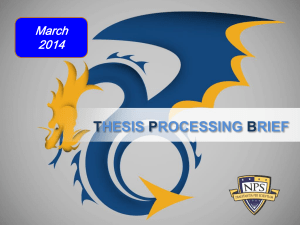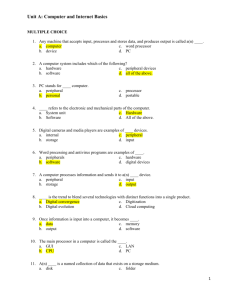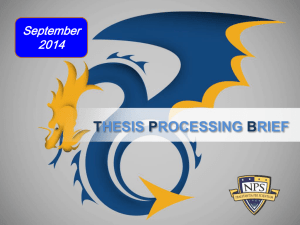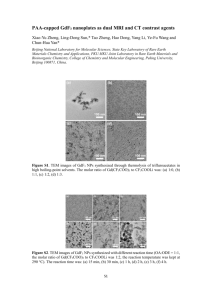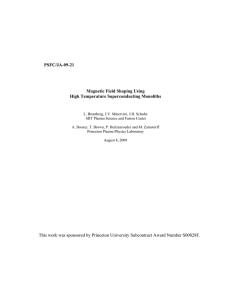RSC Communication Template (Version 3.2)
advertisement
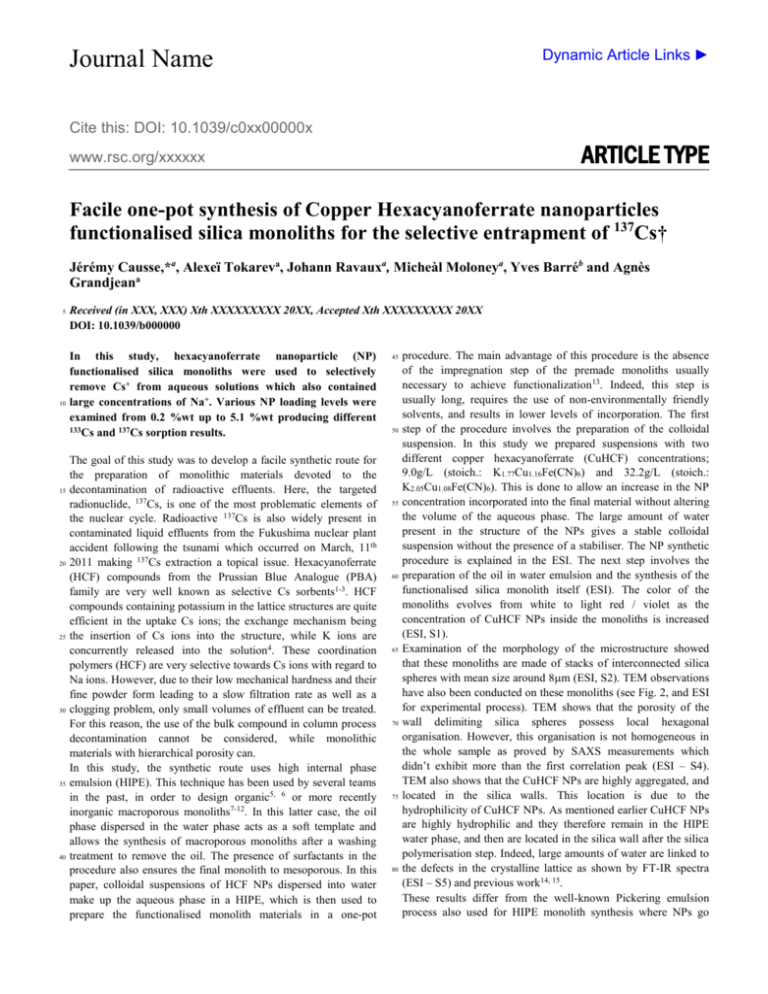
Dynamic Article Links ► Journal Name Cite this: DOI: 10.1039/c0xx00000x ARTICLE TYPE www.rsc.org/xxxxxx Facile one-pot synthesis of Copper Hexacyanoferrate nanoparticles functionalised silica monoliths for the selective entrapment of 137Cs† Jérémy Causse,*a, Alexeï Tokareva, Johann Ravauxa, Micheàl Moloneya, Yves Barréb and Agnès Grandjeana 5 10 15 20 25 30 35 40 Received (in XXX, XXX) Xth XXXXXXXXX 20XX, Accepted Xth XXXXXXXXX 20XX DOI: 10.1039/b000000 In this study, hexacyanoferrate nanoparticle (NP) functionalised silica monoliths were used to selectively remove Cs+ from aqueous solutions which also contained large concentrations of Na+. Various NP loading levels were examined from 0.2 %wt up to 5.1 %wt producing different 133Cs and 137Cs sorption results. The goal of this study was to develop a facile synthetic route for the preparation of monolithic materials devoted to the decontamination of radioactive effluents. Here, the targeted radionuclide, 137Cs, is one of the most problematic elements of the nuclear cycle. Radioactive 137Cs is also widely present in contaminated liquid effluents from the Fukushima nuclear plant accident following the tsunami which occurred on March, 11th 2011 making 137Cs extraction a topical issue. Hexacyanoferrate (HCF) compounds from the Prussian Blue Analogue (PBA) family are very well known as selective Cs sorbents1-3. HCF compounds containing potassium in the lattice structures are quite efficient in the uptake Cs ions; the exchange mechanism being the insertion of Cs ions into the structure, while K ions are concurrently released into the solution4. These coordination polymers (HCF) are very selective towards Cs ions with regard to Na ions. However, due to their low mechanical hardness and their fine powder form leading to a slow filtration rate as well as a clogging problem, only small volumes of effluent can be treated. For this reason, the use of the bulk compound in column process decontamination cannot be considered, while monolithic materials with hierarchical porosity can. In this study, the synthetic route uses high internal phase emulsion (HIPE). This technique has been used by several teams in the past, in order to design organic5, 6 or more recently inorganic macroporous monoliths7-12. In this latter case, the oil phase dispersed in the water phase acts as a soft template and allows the synthesis of macroporous monoliths after a washing treatment to remove the oil. The presence of surfactants in the procedure also ensures the final monolith to mesoporous. In this paper, colloidal suspensions of HCF NPs dispersed into water make up the aqueous phase in a HIPE, which is then used to prepare the functionalised monolith materials in a one-pot 45 50 55 60 65 70 75 80 procedure. The main advantage of this procedure is the absence of the impregnation step of the premade monoliths usually necessary to achieve functionalization13. Indeed, this step is usually long, requires the use of non-environmentally friendly solvents, and results in lower levels of incorporation. The first step of the procedure involves the preparation of the colloidal suspension. In this study we prepared suspensions with two different copper hexacyanoferrate (CuHCF) concentrations; 9.0g/L (stoich.: K1.77Cu1.16Fe(CN)6) and 32.2g/L (stoich.: K2.05Cu1.08Fe(CN)6). This is done to allow an increase in the NP concentration incorporated into the final material without altering the volume of the aqueous phase. The large amount of water present in the structure of the NPs gives a stable colloidal suspension without the presence of a stabiliser. The NP synthetic procedure is explained in the ESI. The next step involves the preparation of the oil in water emulsion and the synthesis of the functionalised silica monolith itself (ESI). The color of the monoliths evolves from white to light red / violet as the concentration of CuHCF NPs inside the monoliths is increased (ESI, S1). Examination of the morphology of the microstructure showed that these monoliths are made of stacks of interconnected silica spheres with mean size around 8m (ESI, S2). TEM observations have also been conducted on these monoliths (see Fig. 2, and ESI for experimental process). TEM shows that the porosity of the wall delimiting silica spheres possess local hexagonal organisation. However, this organisation is not homogeneous in the whole sample as proved by SAXS measurements which didn’t exhibit more than the first correlation peak (ESI – S4). TEM also shows that the CuHCF NPs are highly aggregated, and located in the silica walls. This location is due to the hydrophilicity of CuHCF NPs. As mentioned earlier CuHCF NPs are highly hydrophilic and they therefore remain in the HIPE water phase, and then are located in the silica wall after the silica polymerisation step. Indeed, large amounts of water are linked to the defects in the crystalline lattice as shown by FT-IR spectra (ESI – S5) and previous work14, 15. These results differ from the well-known Pickering emulsion process also used for HIPE monolith synthesis where NPs go Dynamic Article Links ► Journal Name Cite this: DOI: 10.1039/c0xx00000x ARTICLE TYPE www.rsc.org/xxxxxx Table 1 Properties of CuHCF NPs functionalised monoliths. Sample CuHCF Coll. Susp. (g/l) Ra [CuHCF] exp. (%wt)b SBET (m²/g)/DBJH (nm) [CuHCF] th. (%wt)c Yield NP (%)d 0.2@SiO2 9.0 0.07 0.2 290/2.6 0.3 66.7 0.4@SiO2 9.0 0.11 0.4 278/2.7 0.6 66.7 0.8@SiO2 9.0 0.24 0.8 383/2.7 1.2 66.7 1.8@SiO2 9.0 0.64 1.8 479/2.7 2.5 72.0 2.9@SiO2 32.2 0.24 2.9 547/3.1 4.4 65.9 5.1@SiO2 32.2 0.64 5.1 643/6.2 8.4 60.7 𝑉 Ratio of CuHCF colloidal suspension over to surfactant solution defined as 𝑅 = 𝑐𝑜𝑙𝑙.𝑠𝑢𝑠𝑝.⁄𝑉 . b Given by ICP-AES measurements after monolith dissolution. c Given by calculation with 𝑠𝑢𝑟𝑓𝑎𝑐𝑡𝑎𝑛𝑡 𝑠𝑜𝑙𝑢𝑡𝑖𝑜𝑛 regard to the total amount of colloidal suspension used in the synthesis procedure. d Ratio between experimental and theoretical concentration of CuHCF nanoparticles in the final monolith a 5 10 15 towards the oil water interface to stabilise emulsions16, 17.This has been confirmed with interfacial tension measurements which show no drastic effect of CuHCF NPs on the dodecane/water interface. Therefore, most of CuHCF are in the water phase and only a few are located at the dodecane/water interface. Table 1 shows the main properties of the synthesised monoliths. It is noteworthy that some NPs are lost during the solvent washing treatment with retention rates between 60.7% and 72.0%. In addition, the porous properties change gradually with the concentration of NPs entrapped in the material. It is clear therefore that the presence of CuHCF NPs plays a role on porous surface and mesopore size of monoliths. This effect will be discussed later in a future paper. [NP]=9,0g/l [NP]=9.0 g/l [NP]=32,2g/l [NP]=32.2 g/l 0,1 4 (mmol/g) 0,08 3 2,5 0,06 Cs 1,5 macroporosity (mmol/g) 2 0,04 aggregated NPs CuHCF Monolith 40 /m /m 35 Cs Q 30 out by immersing a given mass of each monolith in an aqueous solution containing CsNO3 (1.10-4 mol/L) and CH3COONa (1.103 mol/L) in order to check the materials selectivity towards Cs. It was necessary to use Cs concentration above that of real world conditions (i.e. Fukushima sea water) as to allow for detection with an ionic chromatography device. For each measurement, a certain mass of functionalised monoltih was used to ensure that the sorption conditions were well above that of CuHCF NP saturation with Cs. The remaining Cs concentration after sorption was then measured. The total Cs entrapped in the monoliths is plotted in Fig. 1. The red data shows, as expected, that the higher the NP concentration inside the monoliths, the more Cs is extracted from aqueous solution. Secondly, Cs extraction performed with monoliths prepared with the more concentrated colloidal suspension is slightly larger. This effect is due to the higher stoichmetric potassium content within the crystalline structure of this batch of CuHCF. Q 3,5 25 1 0,02 wall of a silica sphere 0,5 0 0 1 2 3 4 5 6 90 100 %NP Fig. 1 Cs sorption results as a function of CuHCF Nps mass ratio in the 20 100nm monoliths. QCs refers to the quantitiy of Cs adsorbed. [NP] refers to concentration of NPs in the colloidal suspension used for the preparation of monoliths The Cs sorption results clearly show the efficiency of the functionalised monoliths (Fig. 1). These experiments were carried Fig. 2 TEM images of 5.10@SiO2 45 The amount of Cs entrapped in the monolith normalised with regard to the total mass of NPs present in the monolith 5 10 15 (QCs/mCuHCF) decreases as the NP concentration is increased. This continues with the value getting closer and closer to the value obtained for bulk CuHCF (powder of pure CuHCF, values at 100% NP). However, in all cases, this normalised capacity is always higher when functionalised monolith samples are used compared to the bulk material. This evolution shows that the lower the NP content the higher the normalised sorption capacities. We would argue that this is due to the NP aggregation effect within monoliths. As the concentration of NP increases so too does the degree of aggregation. This aggregation effect leads to a decrease in the surface area available to the Cs and has been described in the literature as “nanosize effect”18. This nanoparticle aggregation has been as already mentioned observed by TEM (figure 2 and ESI for experimental procedure). Table 2 shows results obtained with radioactive cesium. In this case, the distribution coefficient is used to assess selectivity and capability of the materials to decontaminate radioactive effluents. This value is noted Kd (ml/g) and is expressed as follows: 𝐾𝑑 = 20 25 30 (𝐴0 −𝐴𝑒𝑞 ) 𝑉 𝐴𝑒𝑞 𝑚𝐶𝑢𝐻𝐶𝐹 (1) where A0 is the initial radioactivity, Aeq the radioactivity at equilibrium after sorption, V (ml) is the volume of the effluent used for the experiment and mCuHCF (g) is the mass of CuHCF present in the solid sample. Kd* is the distribution coefficient normalised with monolith mass instead of CuHCF mass. The initial solution activity was 41.2 kBq/L corresponding to Cesium concentrations of about 9.10-11mol/L. In order to simulate unusual situations, such as contaminated seawater in the case of Fukushima effluents, the initial solution was enriched with salts (ESI). Table 2 Distribution coefficients Kd* for monolith, Kd for CuHCF Nps mass in the monolith and bulk materials Sample Kd* (ml/g) Kd (ml/g) 35 40 45 50 55 0.2@SiO2 2.4 103 1.2 106 1.8@SiO2 3.0 104 1.7 106 5.1@SiO2 1.1 105 2.2 106 60 65 70 75 Notes and references a 80 85 Institut de Chimie Séparative de Marcoule, ICSM, UMR 5257, CEACNRS-UM2-ENSCM, BP17171, 30207 Bagnols sur Cèze, France. Fax: +33 466 797 611; Tel:+33 466 397 421; E-mail: jeremy.causse@cea.fr b CEA/DEN/DTCD/SPDE, Laboratoire des Procédés Supercritiques et de Décontamination, BP17171, 30207 Bagnols sur Cèze, France † Electronic Supplementary Information (ESI) available: [SAXS data, FT-IR data, TEM images, ESEM images]. See DOI: 10.1039/b000000x/ 1. 90 Bulk 32g/L 3.1 106 3.1 106 Table 2 shows Kd* and Kd for 3 functionalised monoliths and bulk CuHCF. It is well known that the presence of sodium ions interfere with cesium sorption by ABP compounds19. However, in our case, even with concentrations of sodium and other cations far in excess of the Cs, distribution coefficients level remains very high. As expected, Kd* values increase with CuHCF NPs ratio and finally reach 1.1 105 ml/g for the monolith loaded with 5.1 %wt of CuHCF NPs. This value can be compared to results obtained for other nanocomposites and radioactive cesium in past studies. Many authors used HCFs with various transition metals (Cu, Co, Zn, Ni) to functionalise organic (PAN, ion exchanger) or inorganic (powder, beads - SiO2, ZrO2, Al2O3, Fe3O4) supports. The values of Kd* are found to be between 5.6 103 ml/g and 5 104 ml/g for solutions with lower activities (20 kBq/L, 10 kBq/L, 1.47 kBq/L)15, 20-23. To the best of our knowledge, only Delchet and al. synthesised nanocomposites for 137Cs with higher values of Kd*, up to 8.105 mL/g18. However, experimental conditions were different with lower activity in the 137Cs solution (20 kBq/L) and with a lower concentration of sodium ions (0.42 mol/L). This is therefore quite hard to use as a true comparison. However, the values for Kd* obtained with the monoliths developed in this work are competitive with regard to other studies carried out in the recent past. It should therefore be borne in mind that monolithic materials allow for a dynamic treatment process on 137Cs contaminated effluents to be performed. Table 2 also shows high Kd (above 106 ml/g) for the three functionalised monoliths and bulk CuHCF material. However, the evolution of Kd differs from the results shown for non-radioactive Cesium in figure 1. This is due to the very low Cesium concentration in the case of radioactive effluents. Indeed, 137Cs concentrations are so low (~10-11 mol/L) that the CuHCF NPs are very far from saturation. Therefore, the NPs aggregation observed inside the monoliths has no drastic effect in such conditions. While the Kd values should be identical for each of these samples, they are not. Table 2 shows a slight increase in the Kd values as NPs concentration in the monoliths increases. This is due to the greater accessibility for Cs to NPs surface caused by increased mesopore size for monoliths with high CuHCF NPs content, from 2.6nm for 0.2@SiO2 to 6.2nm for 5.1@SiO2 (Table 1). Therefore, the high Kd values obtained for all materials show good accessibility of NPs for Cs ions even if NPs are located in silica walls with quite low mesopore sizes. 2. 3. 95 100 4. 5. 6. 7. 8. 9. 10. 105 11. 12. 110 13. 14. 115 15. 16. J. B. Ayers and W. H. Waggoner, Journal of Inorganic and Nuclear Chemistry, 1971, 33, 721-733. I. M. Ismail, M. R. El-Sourougy, N. A. Moneim and H. F. Aly, J. Radioanal. Nucl. Chem., 1998, 237, 97-103. C. Loos-Neskovic, S. Ayrault, V. Badillo, B. Jimenez, E. Garnier, M. Fedoroff, D. J. Jones and B. Merinov, Journal of Solid State Chemistry, 2004, 177, 1817-1828. P. A. Haas, Sep. Sci. Technol., 1993, 28, 2479-2506. P. Hainey, I. M. Huxham, B. Rowatt, D. C. Sherrington and L. Tetley, Macromolecules, 1991, 24, 117-121. N. R. Cameron, Polymer, 2005, 46, 1439-1449. A. Imhof and D. J. Pine, Nature, 1997, 389, 948-951. B. P. Binks, Adv. Mater., 2002, 14, 1824-1827. F. Carn, A. Colin, M. F. Achard, H. Deleuze, E. Sellier, M. Birot and R. Backov, Journal of Materials Chemistry, 2004, 14, 1370-1376. J. G. Alauzun, S. Ungureanu, N. Brun, S. Bernard, P. Miele, R. Backov and C. Sanchez, Journal of Materials Chemistry, 2011, 21, 14025. N. Brun, S. R. S. Prabaharan, C. Surcin, M. Morcrette, H. Deleuze, M. Birot, O. Babot, M. F. Achard and R. Backov, Journal of Physical Chemistry C, 2012, 116, 1408-1421. S. Ungureanu, G. Sigaud, G. L. Vignoles, C. Lorrette, M. Birot, A. Derré, O. Babot, H. Deleuze, A. Soum, G. Pécastaings and R. Backov, Journal of Materials Chemistry, 2011, 21, 14732. N. Gartmann, C. Schütze, H. Ritter and D. Brühwiler, The Journal of Physical Chemistry Letters, 2009, 1, 379-382. S. Adak, L. L. Daemen, M. Hartl, D. Williams, J. Summerhill and H. Nakotte, Journal of Solid State Chemistry, 2011, 184, 2854-2861. R. R. Sheha, Journal of colloid and interface science, 2012, 388, 2130. R. Aveyard, B. P. Binks and J. H. Clint, Advances in Colloid and Interface Science, 2003, 100-102, 503-546. 5 10 15 17. N. Brun, S. Ungureanu, H. Deleuze and R. Backov, Chem. Soc. Rev., 2011, 40, 771-788. 18. C. Delchet, A. Tokarev, X. Dumail, G. Toquer, Y. Barre, Y. Guari, C. Guerin, J. Larionova and A. Grandjean, RSC Adv., 2012, 2, 57075716. 19. A. Nilchi, R. Saberi, M. Moradi, H. Azizpour and R. Zarghami, Chemical Engineering Journal, 2011, 172, 572-580. 20. T. P. Valsala, A. Joseph, J. G. Shah, K. Raj and V. Venugopal, Journal of Nuclear Materials, 2009, 384, 146-152. 21. R. Turgis, G. Arrachart, C. Delchet, C. Rey, Y. Barré, S. PelletRostaing, Y. Guari, J. Larionova and A. Grandjean, Chemistry of Materials, 2014, Online. 22. V. V. Milyutin, S. V. Mikheev, V. M. Gelis and E. A. Kozlitin, Radiochemistry, 2009, 51, 298-300. 23. S. Tsuruoka, B. Fugetsu, F. Khoerunnisa, D. Minami, K. Takeuchi, M. Fujishige, T. Hayashi, Y. A. Kim, K. C. Park, M. Asai, K. Kaneko and M. Endo, Materials Express, 2013, 3, 21-29.



